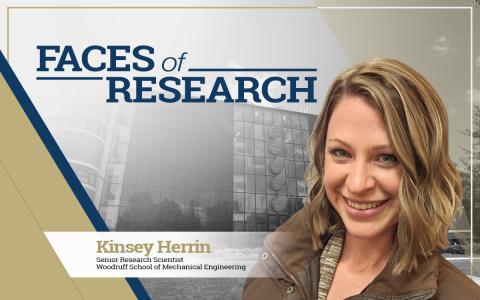The Institute for Robotics and Intelligent Machines at Georgia Tech supports and facilitates the operation of several core research facilities on campus. This allows faculty, students, and collaborators to advance the boundaries of robotics research.
This installment of the Faces of Research Q&A series is with Kinsey Herrin
What is your field of expertise and why did you choose it?
I’m a prosthetist/orthotist and conduct research in the field of prosthetics, orthotics/exoskeletons, and rehab robotics. Our goal is to make it easier for people with mobility challenges to live more independent lives by helping them move more easily in the real world. The change we see through our technology sometimes is amazing — people with amputations can go upstairs, step-over-step instead of stiff legged, and kids with walking disabilities start to have more normal walking patterns. As a kid, I always wanted to help people and this profession is the perfect blend of medicine, science, and art — all things that I love plus the added benefit of getting to be around some really incredible people.
What makes Georgia Tech Research institutes unique?
We’re trying to advance technology outside of the lab and into the real world where it can make an impact on real users. That means not only assessing how our users perform with the technology — does it actually make them walk faster, with a more natural and easy gait — but also assessing a user’s own perspective on technology and using all of that data to keep improving the end results. Our facilities and resources are incredible. I often feel I have access to a dream playground for a research prosthetist/orthotist. On top of all of that, our faculty and students are not only extremely talented and at the top of their fields, but I think there is a deeper passion for pursuing this goal to make mobility easier for people with physical challenges.
What impact is your research having on the world?
I see our work as having an impact on all people with mobility challenges. We are trying to make the world a better place for them by challenging the status quo and saying what clinicians can currently provide is still not good enough. We can still do more to return people to a new normal after amputation, stroke, brain, and spinal cord injuries. When people can access their own environment independently, it has overwhelmingly positive impacts on their quality of life. I think our research is making great strides toward making that possible.
What do you like to do in your spare time when you are not working on your research or teaching?
I enjoy being outdoors with my husband and son any chance we get. We love pretty much everything about being on or near water — fishing, kayaking, canoeing, swimming, and camping. I also have nine backyard chickens and a dog that are hilarious and fun additions to the Herrin chaos.

